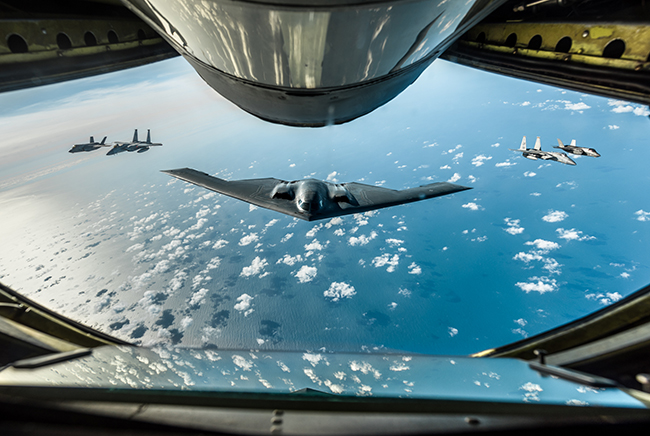The United Kingdom’s Royal Air Force is emulating the US Air Force’s Rapid Capabilities Office, creating its own RCO to swiftly field new aircraft gear, and will pursue a version of USAF’s new “Century Series” initiative in developing its own next-generation combat aircraft, the Tempest.
Even with these steps, however, the RAF commander said he sees no changes for Britain’s involvement with the F-35 program.
Air Chief Marshal Michael Wigston, head of the RAF, told AFA’s Mitchell Institute for Aerospace Studies on Oct. 11 that the RCO idea was “was born on this side of the Atlantic, but when we saw the model and what it was capable of, there was no question we needed to bring it in.”
He credited the RAF’s RCO with “some remarkable successes” in providing “some dispensables” and in reducing the risk in the Tempest, also known as the Future Combat Air System. The Tempest is a stealthy combat aircraft with a front end that resembles that of the F-35.
The challenge for both organizations, he said, is in scaling up what they produce to be applicable to the entire force. Britain’s RCO has “proved its worth … in terms of introducing the next generation of expendable decoys, lightweight ‘swarming’ drones and other capabilities,” he noted. Scaling up successful demonstrations is something “we’re wrestling with at the moment.”
The secret, Wigston said, is to “get the right team around the table from day zero, with the right mindset” and the authority to knock down barriers and “not take ‘no’ for an answer.”
The RAF has already launched 80 programs and let 160 contracts on Tempest-enabling technologies, “across the range of capabilities you would imagine go into a future combat air system,” Wigston said. It’s not been decided that the jet will be manned, he said, although there may be a manned aircraft “at the center, with ‘loyal wingmen’ and the like” around it.
Tempest sets the pace for USAF’s Digital Century Series initiative, and “this is where competition is a really good thing,” he said. The ambitions for USAF’s Next-Generation Air Dominance (NGAD) system and Tempest match, Wigston asserted, but “I think it will bring out the best in both our aerospace sectors and the way our government contracts with our aerospace sector.”
The prize is not just in achieving new combat capabilities but “finding a whole new way of working with our industrial sector, where we get the platform we need faster, and frankly, cheaper,” he said. Companies will be incentivized to produce quickly and effectively, but the government is “not being over-prescriptive in defining the capability that we need.”
France, Germany, and Spain are also exploring a similar concept with the New Generation Fighter.
“This is going to be a really exciting decade ahead as we learn from the experience of introducing fifth-generation platforms,” he said.
Wigston said he thinks a five-year aircraft development cycle, such as that proposed by Air Force acquisition chief Will Roper, is achievable. The Tempest will likely start filling in behind early tranches of retiring Typhoon fighters starting in the 2030s, and completely replace the type in the 2040s, he said.
He also said BAE’s partnership with Saab of Sweden is critical in the development of Tempest. He admires the speed and culture with which Saab modernized and spirally improved the JAS-39 Gripen C to the E model.
“I look at that, and I say, that is exactly what I want,” he said.
Wigston said July saw the “first international fifth-generation training,” where US B-2 bombers and British F-35s practiced operating together. He said there’s an increased pace of both training for joint fifth-gen operations such as this summer’s Point Blank exercises, and practicing putting F-35s down in places like Italy—another F-35 partner—and having them serviced, re-armed and launched again. British F-35s will practice alongside Marine Corps F-35s when the new British Carrier Queen Elizabeth II conducts sea trials off the US east coast very soon, he noted.
While it’s “definitely a discussion for the future” of whether Britain needs F-35As as well as F-35Bs—the conventional takeoff and short takeoff/vertical landing variants, respectively—the UK is committed to a buy of at least 138 F-35s, at least for “the next few block buys and confirmed orders,” Wigston said.
Britain understands the reasoning behind the US’s decision to oust Turkey from the F-35 program, and “I would absolutely recognize that we have to be constantly on our guard for migration of any of the technologies for F-35 to Russia or any other potential adversary.” Turkey is being ejected from the F-35 consortium over its adamance in buying the Russian S-400 air defense system, which could compromise secrets about the F-35’s stealth properties.
“I’m very confident the program will continue and adjust for the absence of Turkey,” Wigston asserted. “Clearly, we would all prefer to see Turkey as remaining as part of the program … but there’s no debate about the decision. It’s just regrettable that we are where we are.”


